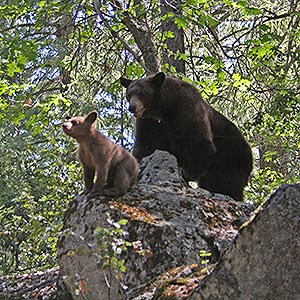
NPS Photo / Tammy Evans
In addition to the overall size of a population, managers keep track of other characteristics of bears, such as the ratio of males to females, proportion of individuals of different ages, and genetic diversity. This information is crucial in understanding how events such as droughts, fires, and invasions of exotic species; hunting; and land use changes and development affect bear populations.
For example, there are questions about the degree to which the decline in whitebark pine seeds affect bear survival, especially grizzly bears. For bears that live in mountainous areas of the western United States, such as Yellowstone, Grand Teton, and Glacier national parks, whitebark pine seeds are an important food source. A great source of calories for bears, whitebark pine seeds can overwinter and are therefore an easily accessible food source in the spring. However, whitebark pine communities are declining largely because of blister rust, an exotic fungus that kills whitebark pines. Further whitebark pine mortality is caused by increased populations of mountain pine beetles. These bark beetles are native, but their populations have increased greatly due to climate change. Variability in the supply of whitebark pine cones may affect bear movements and foraging strategies. As omnivores, bears are able to eat a wide variety of foods, and whitebark pine seeds are only one of their main food sources. Recent studies support bears’ ability to switch to different foods based on availability. This “dietary plasticity” is what allows bears to occupy such a diverse range of ecosystems. An integral part of the Yellowstone grizzly recovery effort is annual monitoring of major food sources.
In some parks, hunting bears is allowed for subsistence or recreational purposes. Knowledge about populations helps managers make decisions about the number and type of animals that may be harvested without causing negative effects to the overall population. The creation of Lake Clark National Park and Preserve in an extremely rural part of Alaska ensured that local people could continue to rely on park and preserve lands for subsistence hunting. Bears are an important source of meat, fat, and hides for rural people who are often isolated due to weather and lack of infrastructure. Lake Clark maintains balance between bear persistence and the needs of local residents by establishing a harvest quota.
Bear populations also may be affected by roads in parks. Following speed limits can reduce bear and human fatalities from vehicle collisions. Yosemite National Park works to decrease vehicle-bear collisions through an education campaign and visible signs in places where bears have been hit. While it can be exciting to view bears from the road, “bear jams” can sometimes become quite large and cause safety hazards for other motorists and also may affect bear behavior.
Last updated: April 18, 2016
